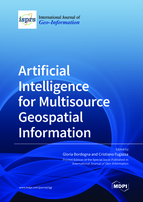Artificial Intelligence for Multisource Geospatial Information
A special issue of ISPRS International Journal of Geo-Information (ISSN 2220-9964).
Deadline for manuscript submissions: closed (31 January 2022) | Viewed by 33750
Special Issue Editors
Interests: fuzzy logic and soft computing for the representation and management of imprecision and uncertainty of textual and geographic information; volunteered geographic information user-driven quality assessment in citizen science; crowdsourced information spatiotemporal analytics; information retrieval on the web; flexible query languages for information retrieval and geographic information systems; ill-defined environmental knowledge representation and management; multisource geographic information fusion and synthesis
Special Issues, Collections and Topics in MDPI journals
Special Issue Information
Dear Colleague,
This Special Issue is collecting original research contributions focused on the definition and application of artificial intelligence methods for acquisition, filtering, management, analysis, discovery, and visualization of geospatial information from multiple sources, i.e., geospatial big data: open geospatial data, remote sensing images and derived products, IoT georeferenced data, crowdsourced geotagged information from social networks, and volunteered geographic information. Key applications are Earth observation for territorial monitoring and change detections, including urban and land-use dynamics and anomaly detection; social condition and habit detection, characterization, monitoring, and prediction regarding, for example, poverty locations, citizens mobility, work, and recreation; event detection and forecasting for emergency preparedness and management, and many more.
This field, also referred to as geospatial artificial intelligence (or geoAI), applies many techniques of the most general artificial intelligence (AI), such as machine learning, deep learning, knowledge discovery, data mining, and soft computing, and semantic representation and analysis. In fact, recent studies aim to bridge the gap between most of these technologies and more traditional approaches to knowledge management; thus, easing advanced features such as explainable AI. However, the specificities and importance of the geospatial dimension, its heterogeneity in terms of both conceptualization (place versus space) and scales, the need for representing distinct semantics of locations, as well as analyzing the role of their temporal changes by performing geospatial and temporal reasoning pose new challenges and opportunities that AI has to face.
Topics of interest include but are not limited to the following:
- Definition of novel methods for temporal mining of geospatial events so as to be able to identify their latency period in specific areas, possible periodicity, and contributing physical and environmental factors. This can exploit VGI and social network information, remote sensing derived proxies, and historic geospatial data;
- Geo big data synthesis and reduction approaches modeling uncertainty and different reliability of the sources, the accuracy of the geospatial data, its incompleteness, complementarity, redundancy, possible inconsistency, and conflicts;
- Enhancement of low spatiotemporal and spectral resolution imagery by new operators of multiple source fusion to improve feature and image recognition;
- Geospatial data science methods for image interpretation;
- Visual-based database creation that encapsulates spatial data and location information: for example, by automatic interpretation of cartographic maps through the separation of text (such as names of places) from map features, for automatic feature naming; by automated data capture and extraction of words or other information from photographs to describe points of interest;
- Mobile application design for real-time suggestions of information about places exploiting social networks and web contents;
- Augmented reality methods for improving real time geospatiotemporal data visualization and navigation, for example, to manage crowded spaces;
- Knowledge graphs and ontologies for geospatial data representation and reasoning.
Dr. Gloria Bordogna
Dr. Cristiano Fugazza
Guest Editors
Manuscript Submission Information
Manuscripts should be submitted online at www.mdpi.com by registering and logging in to this website. Once you are registered, click here to go to the submission form. Manuscripts can be submitted until the deadline. All submissions that pass pre-check are peer-reviewed. Accepted papers will be published continuously in the journal (as soon as accepted) and will be listed together on the special issue website. Research articles, review articles as well as short communications are invited. For planned papers, a title and short abstract (about 100 words) can be sent to the Editorial Office for announcement on this website.
Submitted manuscripts should not have been published previously, nor be under consideration for publication elsewhere (except conference proceedings papers). All manuscripts are thoroughly refereed through a single-blind peer-review process. A guide for authors and other relevant information for submission of manuscripts is available on the Instructions for Authors page. ISPRS International Journal of Geo-Information is an international peer-reviewed open access monthly journal published by MDPI.
Please visit the Instructions for Authors page before submitting a manuscript. The Article Processing Charge (APC) for publication in this open access journal is 1700 CHF (Swiss Francs). Submitted papers should be well formatted and use good English. Authors may use MDPI's English editing service prior to publication or during author revisions.







